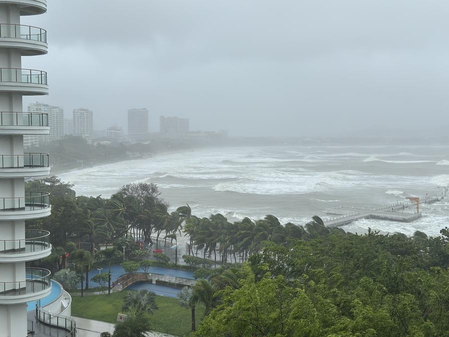

Hangzhou, July 30 (IANS) Co-May, the eighth typhoon of this year, made landfall in east China’s Zhejiang Province at about 4.30 a.m. Wednesday, according to the provincial meteorological observatory.
The typhoon, with the maximum wind force near its centre reaching 23 metres per second, churned ashore at Zhoushan City of Zhejiang, Xinhua news agency reported.
Zhejiang upgraded the emergency response level for Typhoon Co-May from IV to III at 3.00 p.m. on Tuesday, according to the provincial emergency management department.
China has a four-tier emergency response system, with Level I being the most severe response.
Earlier on July 28, China’s Ministry of Water Resources had activated a Level-IV emergency flood response in four provincial-level regions — Shanghai, Jiangsu, Anhui and Jiangxi — in response to Typhoon Co-May, the eighth typhoon of the year.
Till Saturday, torrential rain is forecast in areas including Zhejiang, Shanghai, Anhui, Jiangsu and Jiangxi. Rivers and waterways around Taihu Lake may see sharp water level rises, with some small and medium rivers likely to exceed flood warning levels.
On Monday, the ministry also launched a Level-IV response in Xinjiang and the Xinjiang Production and Construction Corps due to snowmelt-driven flooding caused by persistent high temperatures. Floods along the Tarim River and its tributaries are expected to continue into mid-August.
Authorities had urged close monitoring of weather conditions, early warnings, and strengthened flood control measures to safeguard lives and property.
The typhoon is expected to move northwest at a speed of 15 to 20 km per hour, approaching the eastern part of the East China Sea and nearing the coastal areas of Zhejiang, while gradually intensifying in strength.
Typhoon Wipha, the seventh typhoon of the year, has also impacted China, particularly Hong Kong and Guangdong province, with strong winds and heavy rainfall. The typhoon caused significant disruptions to air travel, public transport, and daily life in Hong Kong, with hundreds of flights cancelled and transport services suspended. The storm also led to flooding in low-lying areas and trapped residents in some regions.
On Monday, Water conservancy authorities announced China’s No.1 flood of major rivers of 2025 in the Luanhe River, located in north China’s Haihe River Basin.
Due to recent heavy rainfall, the Luanhe River has experienced a rise in water levels. At 4.30 a.m. on Monday, the inflow rate at the Panjiakou Reservoir on the main stream of the Luanhe River rose to 2,270 cubic metres per second, according to the Haihe River Water Conservancy Commission of the Ministry of Water Resources.
–IANS
int/jk/svn
